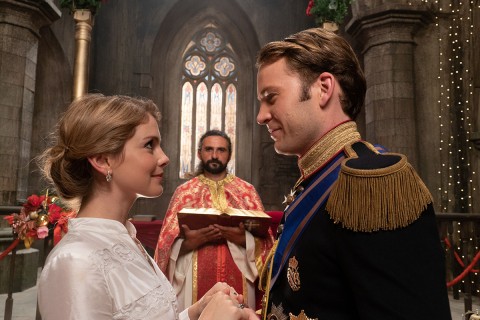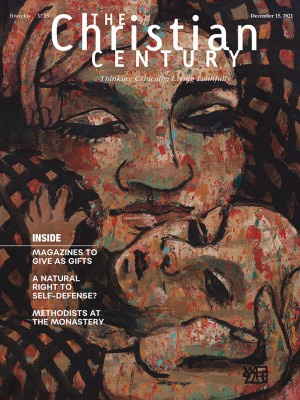’Tis the season for royal Christmas movies
What exactly is it about the birth of our Lord and Savior Jesus Christ that says “tiara romance”?

In 2017, someone at Netflix tweeted from the streaming platform’s account about its new Christmas offering: “To the 53 people who’ve watched A Christmas Prince every day for the past 18 days: Who hurt you?”
The tweet sparked a news cycle’s worth of internet outrage, mostly centered on the creepiness of Netflix’s data capturing and subsequent public sharing, however anonymized, and not on the sentiment of the tweet itself. Perhaps many of us would agree that if you’re watching a movie like A Christmas Prince every day for more than two weeks, something isn’t right.
A Christmas Prince was successful enough to prompt two sequels: A Christmas Prince: The Royal Wedding and A Christmas Prince: The Royal Baby, released for the holiday seasons of 2018 and 2019. Netflix added another royal Christmas franchise in 2018 with The Princess Switch, the third of which came out in 2021, which also brought A Castle for Christmas.
Read our latest issue or browse back issues.
Netflix certainly didn’t start this royal Christmas trend, though it dove in with both feet. The Hallmark Channel produced what is perhaps the first in the genre with A Princess for Christmas in 2011, and it has been the most prolific in producing similar titles since, following up with A Royal Christmas, Crown for Christmas, and Christmas at the Palace.
The Hallmark Christmas film in general has become a relatively well-known genre in American television. The channel itself has religious roots, having originally been shared by two religious broadcasters before being purchased by Hallmark, which “synergized” content with Hallmark Cards, working to become the cable channel most associated with celebration. The most culturally famous of these Hallmark “celebrations” is the annual Countdown to Christmas, in which the royal Christmas movie has become a strong subgenre.
But what exactly is it about the birth of our Lord and Savior Jesus Christ that says “tiara romance,” and why do so many people seem to want it so much?
Royal Christmas movies mostly adhere to a general set of principles. There’s an unassuming (White) American woman with as ordinary a life as possible, and there’s a (White) prince from a nonexistent country in Central Europe called Aldovia or Balemont or Belgravia or Castlebury, where everyone speaks with a British accent. (Presumably it would feel too odd and tasteless to set one of these films in England itself.) There’s a power-hungry aristocratic love rival or an upcoming loveless arranged marriage; there’s probably a ball on Christmas Eve. And wow, is it Christmas. I might not be exaggerating when I say that some of these movies have a Christmas tree in every frame. In The Princess Switch, there’s even a Christmas tree in the stables.
But these poinsettia explosions are Christian only in the vaguest possible sense. There’s the occasional angel in disguise, manipulating events to throw the protagonist in the way of the prince, and there are some moments of cultural signaling. In Christmas with a Prince, when a beautiful hospital pediatrician challenges the chief medical officer about children being moved to accommodate the privacy of a European prince who’s been injured in a skiing accident, she protests that it’s Christmas, that the children deserve to stay in their own rooms. The villainous chief medical officer’s response? “We say happy holidays, Doctor.”
The religiosity of the holiday is too ill- defined to account for the vast Christian audience appeal of these films. Maybe it’s the well-worn, overwhelming Whiteness of the European fairy tale that we find so comforting, though we are less comfortable acknowledging it. It is so easy to take no notice of the exclusivity of the proposition—or of my own latent willingness to accept every one of the structures and tropes of a royal Christmas movie as a chance to imagine, for a couple of hours, that I could be the one.
Back when I was at Episcopal summer camp, my counselor decorated the cabin wall with a drawing of a girl sitting on a bench surrounded by the words “My father is the King of Kings and that makes me a princess.” What, I wondered as I saw this drawing every day on my way to the shower, was the point of being a princess if every other woman on earth was one, too? My faith had not taught me that my culture’s conception of feminine value—beauty, desirability, the love of a man—was wrong but simply that God was its true bestower. By this time in my life, I had hung a poster of Prince William’s face on my closet door and developed a habit of standing in my driveway while playing the Spice Girls’ “Viva Forever” on my Discman, facing what I believed to be the general direction of England. I had more concrete aspirations.
The fairy tale is the story of the one who gets chosen; everyone else remains a peasant. Their drudgery, however marginally ameliorated by your benevolence, continues. Only one woman can marry the crown prince of Fake Britain. To become a princess is to be imbued with value. Gems, gowns, and castles all indicate that the one who wears or inhabits them is the one worthy to do so. The only one. Those are low odds for the women of the world. Given that every single one of these value-bestowing princes is White, and most of the would-be princesses are, too, the vision narrows even further.
But the story of the incarnation (to which these movies claim, however blandly, to owe their existence) is the story of every one of us being chosen. It is a vision not of one raised to the greatest heights of power and value but of the heights themselves dissolving, of royalty stripped and lowered to the absolute depths of human experience. The crown gone, the kingdom unacknowledged, the deference nonexistent. The power diffused on the winds of the earth, leaving only the starkest vulnerability imaginable. That is the royal Christmas love story of the King of Heaven.
Watching two of these movies as an adult, I noticed the problematic structures and implications, but I also remembered standing in my driveway as a preteen with an earnest desire: Choose me. Tell me I am more than I seem, you whom no one would dare contradict, you whose favor, once secured, must be acknowledged by everyone who ever made me feel like I wasn’t important.
Awkwardly, that is not what God offers. In the incarnation, God offers me nothing but that which is offered to everyone. By taking comfort in a narrative so diametrically opposed to this one, we perhaps betray an ambivalence, a preference for the remote possibility of finding our way to the top of the world over a reality that upends the hierarchical foundations of the universe itself. Understandable, perhaps. But it’s worth at least noting that it isn’t only a fictional Europe we’re repopulating with our own myopic desires—it’s Christmas itself.
A version of this article appears in the print edition under the title “Who gets chosen?”






